Portal:Catholic Church/Selected biography
Selected biographies

Saint Peter Claver (in Spanish: Pedro Claver) was a Jesuit who, due to his remarkable life and work, become the patron saint of slaves, of Colombia and of African Americans. Although his detractors often accused Claver of lacking intelligence, boldness and self-confidence, he became a compassionate leader who lived out the commitment he added to his vows: that he was Peter Claver, forever a servant to the blacks. He insisted on seeing the slaves taken from Africa as his brothers in Christ and demanded that his fellow-Christians treat them as equals. As new slaves arrived, Claver ran out to meet them, carrying food and clothes to the living and removing the bodies of those who had died. He cared for the weakest first and took the sick to a nearby hospital he had built. Using natives as interpreters, he then began sharing the Gospel with all who would hear. Having won their good will, he instructed and baptized them into the Faith.
Read more...

Joan of Arc, or Jeanne d'Arc in French, (c. 1412 – May 30, 1431) was a 15th century national heroine of France. She was tried and executed for heresy when she was only 19 years old. The judgment was overturned by the Pope and she was declared innocent and a martyr 24 years later. She was beatified in 1909 and canonized as a saint in 1920. Joan asserted that she had visions from God which told her to recover her homeland from English domination late in the Hundred Years' War. The uncrowned King Charles VII sent her to the siege at Orléans as part of a relief mission. She gained prominence when she overcame the dismissive attitude of veteran commanders and lifted the siege in only nine days. Several more swift victories led to Charles VII's coronation at Reims and settled the disputed succession to the throne.
Read more...
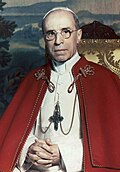
Read more...

Saint Gregory of Nazianzus (329 – January 25, 389), also known as Saint Gregory the Theologian or Gregory Nazianzen, was a 4th century Christian bishop of Constantinople. Gregory is widely considered the most accomplished rhetorical stylist of the patristic age. As a classically trained speaker and philosopher he infused Hellenism into the early church, establishing the paradigm of Byzantine theologians and church officials.Gregory made a significant impact on the shape of Trinitarian theology among both Greek-speaking and Latin-speaking theologians, and he is remembered as the "Trinitarian Theologian." Much of his theological work continues to influence modern theologians, especially in regard to the relationship among the three persons of the Trinity.
Read more...
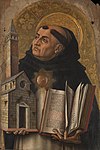
Thomas Aquinas, O.P. (also Saint Thomas Aquinas, Thomas of Aquin, or Aquino; c. 1225 – 7 March 1274) was an Italian Catholic priest in the Order of Preachers (more commonly known as the Dominican Order), a philosopher and theologian in the scholastic tradition, known as Doctor Angelicus, Doctor Universalis and Doctor Communis. He was the foremost classical proponent of natural theology, and the father of the Thomistic school of philosophy and theology. Aquinas is held in the Catholic Church to be the model teacher for those studying for the priesthood (Code of Canon Law, Can. 252, §3). The works for which he is best-known are the Summa Theologica and the Summa Contra Gentiles.
Read more...
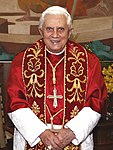
Pope Benedict XVI (Latin: Benedictus PP. XVI; German Benedikt XVI.; Italian: Benedetto XVI, born Joseph Alois Ratzinger on 16 April 1927) was the 265th Pope, the spiritual head of the Catholic Church, and as such, Sovereign of the Vatican City State, until his resignation was effective, on 28 February 2013. He was elected on 19 April 2005 in a papal conclave, celebrated his papal inauguration mass on 24 April 2005, and took possession of his cathedral, the Basilica of St. John Lateran, on 7 May 2005. Pope Benedict XVI has both German and Vatican citizenship. He succeeded Pope John Paul II, who died on 2 April 2005 (and with whom he had worked before the Sede vacante). Benedict XVI was also the Bishop of Rome. Benedict XVI is a well-known Catholic theologian and a prolific author, a defender of traditional Catholic doctrine and values.
Read more...
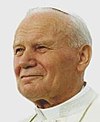
Pope John Paul II (Latin: Ioannes Paulus PP. II, Italian: Giovanni Paolo II, Polish: Jan Paweł II) born ⓘ [ˈkaɾɔl ˈjuzεf vɔi̯ˈtɨwa]; 18 May 1920 – 2 April 2005) reigned as the 264th Pope of the Roman Catholic Church and Sovereign of the State of the Vatican City from 16 October 1978, until his death, almost 27 years later, making his the second-longest pontificate in modern times after Pius IX's 31-year reign. He is the only Polish pope, and was the first non-Italian pope since the Dutch Adrian VI in the 1520s. He is one of only four people to have been named to the Time 100 for both the 20th century and for a year in the 21st. Canonized in 2014, he was made the patron of World Youth Day even before canonization, for 2008 in Sydney, Australia. He started those days for youth in 1986.
Read more...

John Chrysostom (349– ca. 407, Greek: Ιωάννης ο Χρυσόστομος, Latin: Ioannes Chrysostomos) was the archbishop of Constantinople. He is known for his eloquence in preaching and public speaking, his denunciation of abuse of authority by both ecclesiastical and political leaders, the Liturgy of St. John Chrysostom, and his ascetic sensibilities. After his death (or, according to some sources, during his life) he was given the Greek surname chrysostomos, meaning "golden mouthed", rendered in English as Chrysostom.The Orthodox Church and Eastern Catholic Churches honor him as a saint (feast days: November 13 and January 27) and count him among the Three Holy Hierarchs (feast day, January 30), together with Saints Basil the Great and Gregory the Theologian. He is recognized by the Roman Catholic Church as a saint and a Doctor of the Church.
Read more...
Asser (d. 908/909) was a Welsh monk from St. David's, Dyfed, who became Bishop of Sherborne in the 890s. In about 885 he was asked by Alfred the Great to leave St. David's and join the circle of learned men which Alfred was recruiting for his court. After spending a year at Caerwent due to an illness, he accepted. In 893 Asser wrote a biography of Alfred, called the Life of King Alfred. The manuscript survived to modern times in only one copy, which was part of the Cotton library. That copy was destroyed in a fire in 1731, but transcriptions that had been made earlier, allied with material from Asser's work that was included by other early writers, have enabled the work to be reconstructed. The biography is now the main source of information about Alfred's life, and provides far more information about Alfred than is known about any other early English ruler. Asser also assisted Alfred in his translation of Gregory the Great's Pastoral Care, and possibly with other works. Asser is sometimes cited as a source for the legend of Alfred having founded the University of Oxford, which is now known to be false. A short passage making this claim was interpolated by William Camden into his 1603 edition of Asser's Life. Doubts have also been raised periodically about whether the entire Life is a forgery, written by a slightly later writer, but it is now almost universally accepted as genuine.
Read more...

Charles II was the King of England, Scotland and Ireland from 30 January 1649 until his death. Charles II's father, Charles I, had been executed in 1649 following the English Civil War; the monarchy was then abolished and replaced with a military dictatorship under Oliver Cromwell, who had named himself "Lord Protector". In 1660, shortly after Cromwell's death, the monarchy was restored under Charles II. Unlike his father, Charles II was skilled at managing Parliament. It was during his reign that the Whig and Tory political parties developed. He famously fathered numerous illegitimate children, of whom he acknowledged fourteen. Known as the "Merry Monarch", Charles was a patron of the arts and less restrictive than many of his predecessors. By converting to Roman Catholicism on his deathbed, Charles II became the first Roman Catholic to reign over England since Mary I's death in 1558.
Read more...

James VI and I (19 June 1566 – 27 March 1625) was King of Scots as James VI, and King of England and King of Ireland as James I. He ruled in Scotland as James VI from 24 July 1567, when he was only one year old, succeeding his mother Mary, Queen of Scots, who had been forced to abdicate. Regents governed during his minority, which ended officially in 1578, though he did not gain full control of his government until 1581. On 24 March 1603, as James I, he succeeded the last Tudor monarch of England and Ireland, Elizabeth I, who died without issue. He then ruled England, Scotland and Ireland for 22 years, until his death at the age of 58. James achieved most of his aims in Scotland but faced great difficulties in England, including the Gunpowder Plot in 1605 and repeated conflicts with the English Parliament. According to a tradition originating with historians of the mid-seventeenth-century, James's taste for political absolutism, his financial irresponsibility, and his cultivation of unpopular favourites established the foundation for the English Civil War.
Read more...

James II and VII (14 October 1633 – 16 September 1701)was King of England, King of Scots, and King of Ireland from 6 February 1685 to 11 December 1688. He was the last Roman Catholic monarch to reign over the Kingdoms of England, Scotland, and Ireland. Many of his subjects distrusted his religious policies and autocratic tendencies, leading a group of them to depose him in the Glorious Revolution in 1688. He was replaced not by his Roman Catholic son, James Francis Edward, but by his Protestant daughter and son-in-law, Mary II and William III, who became joint rulers in 1689. James made one serious attempt to recover his crowns, when he landed in Ireland in 1689. After his defeat at the Battle of the Boyne in the summer of 1690, James returned to France, living out the rest of his life under the protection of his cousin and ally, King Louis XIV.
Read more...
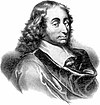
Blaise Pascal (French pronunciation: [blɛz paskal]), (June 19, 1623 – August 19, 1662) was a French mathematician, physicist, and religious philosopher. He was a child prodigy who was educated by his father. Pascal's earliest work was in the natural and applied sciences where he made important contributions to the construction of mechanical calculators, the study of fluids, and clarified the concepts of pressure and vacuum by generalizing the work of Evangelista Torricelli. Pascal also wrote in defense of the scientific method. Pascal was a mathematician of the first order. He helped create two major new areas of research. He wrote a significant treatise on the subject of projective geometry at the age of sixteen, and later corresponded with Pierre de Fermat on probability theory, strongly influencing the development of modern economics and social science. Following a mystical experience in late 1654, he abandoned his scientific work and devoted himself to philosophy and theology. His two most famous works date from this period: the Lettres provinciales and the Pensées. Pascal suffered from ill health throughout his life and died two months after his 39th birthday.
Read more...

Jesus of Nazareth (7–2 BC to 26–36 AD), also known as Jesus Christ, is the central figure of Christianity, revered by most Christians as the incarnation of God, and is also an important figure in several other religions. The name "Jesus" is an Anglicization of the Greek Ίησους (Iēsous), itself a Hellenization of the Hebrew יהושע (Yehoshua) or Hebrew-Aramaic ישוע (Yeshua), meaning "YHWH rescues". "Christ" is a title derived from the Greek Χριστός (Christós), meaning the "Anointed One," which corresponds to the Hebrew-derived "Messiah". The main sources of information regarding Jesus' life and teachings are the gospels. Most scholars in the fields of history and biblical studies agree that Jesus was a Galilean Jew, was regarded as a teacher and healer, was baptized by John the Baptist, and was crucified in Jerusalem on orders of Roman Governor Pontius Pilate, on the charge of sedition against the Roman Empire.
Read more...
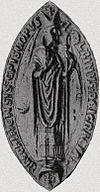
Albin (or Albinus) (d. 1269) was a 13th-century prelate of the Kingdom of Scotland. A university graduate, Albin is known for his ecclesiastical career in the diocese of Brechin, centred on Angus in east-central Scotland. Almost certainly a native of Angus, he appears to be a descendant of David of Scotland, Earl of Huntingdon, brother of King William I of Scotland, through an illegitimate son whom Earl David settled in the area around Brechin. Albin, himself an illegitimate child, made his career as a churchman in the local diocese, and served for some time as precentor of Brechin Cathedral before, in 1246, being elected Bishop of Brechin. He remained Bishop of Brechin until his death in 1269. Albin became Bishop of Brechin following an election and then a successful appeal for confirmation to the papacy. Pope Innocent IV's mandate for confirmation gave the details of the election.
Read more...

Bede (/biːd/; c. 672 or 673 – May 25, 735), also Saint Bede, the Venerable Bede, or (from Latin and Old English) Beda (Old English pronunciation: [ˈbeːdɑ]), was a Benedictine monk at the Northumbrian monastery of Saint Peter at Monkwearmouth, today part of Sunderland, and of its companion monastery, Saint Paul's, in modern Jarrow (see Wearmouth-Jarrow), both Northumbria. He is well known as an author and scholar, and his most famous work, Historia ecclesiastica gentis Anglorum (The Ecclesiastical History of the English People) gained him the title "The father of English history". Bede became known as Venerable Bede (Lat.: Beda Venerabilis) soon after his death, but this was not linked to consideration for sainthood by the Roman Catholic Church. In fact, his title is believed to come from a mistranslation of the Latin inscription on his tomb in Durham Cathedral, intended to be Here lie the venerable bones of Bede, but wrongly interpreted as here lie the bones of the Venerable Bede.
Read more...
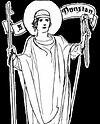
Dunstan (c.909–19 May 988) was an abbot of Glastonbury, a bishop of Worcester, a bishop of London, and an archbishop of Canterbury who was later canonized as a saint. His work restored monastic life in England and reformed the English Church. His 11th century biographer, Osbern, himself an artist and scribe, states that Dunstan was skilled in "making a picture and forming letters", as were other clergy of his age who reached senior rank. Dunstan served as an important minister of state to several English kings. He was the most popular saint in England for nearly two centuries, having gained fame for the many stories of his greatness. Adding to Dunstan's myth was his legendary cunning in dealing with the Devil. As a young boy, Dunstan studied under the Irish monks who then occupied the ruins of Glastonbury abbey.
Read more...

Mother Teresa (Albanian: Agnes Gonxha Bojaxhiu; Albanian pronunciation: [ˈaɡnɛs ˈɡɔndʒa bɔˈjadʒu]) (August 26, 1910 – September 5, 1997) was an Albanian Roman Catholic nun who founded the Missionaries of Charity in Kolkata (Calcutta), India in 1950. For over forty years she ministered to the poor, sick, orphaned, and dying, while guiding the Missionaries of Charity's expansion, first throughout India and then in other countries. By the 1970s she had become internationally famed as a humanitarian and advocate for the poor and helpless, due in part to a documentary, and book, Something Beautiful for God by Malcolm Muggeridge. She won the Nobel Peace Prize in 1979 for her humanitarian work. Mother Teresa's Missionaries of Charity continued to expand, and at the time of her death it was operating 610 missions in 123 countries, including hospices and homes for people with HIV/AIDS, leprosy and tuberculosis, soup kitchens, children's and family counseling programs, orphanages, and schools.
Read more...
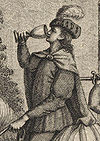
Edward the Martyr or Eadweard II (c. 962–18 March 978) was king of England from 975 until he was murdered in 978. Edward is thought to have been the son of King Edgar and Æthelflæd. His succession to the throne was contested by supporters of his half-brother Æthelred, but with Dunstan's support, Edward was acknowledged by the Witan and crowned king by Dunstan and Oswald of Worcester.Edward's reign was short and disturbed by factional strife. He was killed at Corfe Castle by servants of his stepmother the Queen Dowager Ælfthryth (Elfrida) on 18 March 978. Edward became known as "the Martyr" because of his violent end, the fact that the party opposed to him had been irreligious, and the fact that he himself had always acted as a defender of the Church. Within a short time he was regarded as a saint and his cult was established at Shaftesbury Abbey where he had been reburied circa 980. Many miracles were reported at the tomb of St Edward, including the healing of lepers and the blind.
Read more...
Thomas is the first known Bishop of Finland. Only a few facts remain about his life. He resigned in 1245 and died in Visby three years later.The only reference to Bishop Thomas during his episcopate in Finland is a letter signed by him in Nousiainen in 1234, which granted certain lands around the parish to his chaplain, Wilhelm .The letter is the first surviving letter ever written in Finland.No further information on bishop's activities has survived before he was granted resignation by Pope Innocent IV on 21 February 1245. According to the Pope, Thomas had admitted committing several felonies, like torturing a man to death and forging a papal letter. Church representatives to oversee the resignation were the Archbishop of Uppsala and the Dominican prior of the Dacian province. Thomas donated his books to the newly established Dominican convent in Sigtuna and went on to live his last years in the Dominican convent in Visby, Gotland. He died there in 1248, shortly before the Second Swedish Crusade which cemented the Swedish rule in Finland for more than 550 years.
Read more...
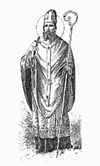
Augustine of Canterbury (died May 26, 604) was a Benedictine monk who became the first Archbishop of Canterbury in 598. He is considered the "Apostle to the English", a founder of the English Church, and a patron of England.Augustine was the prior of a monastery in Rome when Pope Gregory the Great chose him in 595 to lead a mission to Britain to convert the pagan King Æthelberht of Kent to Christianity. Kent was probably chosen because it was near the Christian kingdoms in Gaul, and because Æthelberht had married a Christian princess, Bertha, daughter of Charibert, the King of Paris, who was expected to exert some influence over her husband. Although the missionaries considered turning back before they reached Kent, Gregory urged them on, and in 597 Augustine landed on the Isle of Thanet and proceeded to Æthelberht's main town of Canterbury.
Read more...

Hubert Walter (circa 1160–July 13, 1205) was Chief Justiciar of England and Archbishop of Canterbury in the late twelfth and early thirteenth centuries. He owed his early advancement to his uncle Ranulf de Glanvill, who helped him become a clerk in the Exchequer. Walter served King Henry II of England in many different ways, not only in the financial administration. After an unsuccessful candidacy to the see of York, Walter was elected Bishop of Salisbury shortly after the ascension of King Henry's son Richard I to the throne of England. Walter accompanied King Richard on the Third Crusade and was one of the principal persons involved in raising Richard's ransom after the king had been captured in Germany while returning home from Crusade. As a reward for his faithful service, Walter was selected to become the next Archbishop of Canterbury in 1193. Walter also served as justiciar for Richard until 1198.
Read more...
Thurstan, or Turstin (c. 1070–February 6, 1140) was a medieval Archbishop of York. The son of a priest, he served King William II of England and King Henry I of England before his election to the see of York in 1114. Once elected, his consecration was delayed for five years while he fought attempts by the Archbishop of Canterbury to assert authority over York. Eventually, he was consecrated by the pope and allowed to return to England. While archbishop, he secured two new suffragan bishops for his province. When King Henry I died, Thurstan supported Henry's nephew Stephen of Blois as king. Thurstan also defended the northern part of England from invasion by the Scots, taking a leading part in organizing the English forces at the Battle of the Standard. Shortly before his death, Thurstan resigned from his see and took the habit of a Cluniac monk.Thurstan was the son of a canon of St Paul's in London named Anger or Auger who held the prebend of Cantlers. Another son of Anger, Audoen, was later Bishop of Évreux.
Read more...

William Edington (d. October 6, 1366) was an English bishop and administrator. He served as bishop of Winchester from 1346 until his death, keeper of the wardrobe from 1341 to 1344, treasurer from 1344 to 1356, and finally as chancellor from 1356 until he retired from royal administration in 1363. Edington’s reforms of the administration — in particular of royal finances — had wide-ranging consequences, and contributed to the English military efficiency in the early stages of the Hundred Years' War. As bishop of Winchester he was responsible for starting an extensive rebuilding of Winchester Cathedral, and for founding Edington Priory, the church of which still stands today.His parents were Roger and Amice of Edington near Westbury, Wiltshire. Though it has been claimed that he was educated at Oxford, there seems to be no support for this.
Read more...

Henry de Lichton (de Lychtone, Leighton) (d. 1440), was a medieval Scottish prelate and diplomat, who, serving as Bishop of Moray (1414–1422) and Bishop of Aberdeen (1422–1440), became a significant patron of the church, a cathedral builder and a writer. He also served King James I of Scotland as a diplomat in England, France and Italy. He was born in the diocese of Brechin (probably Angus) somewhere between 1369 and 1379 to Henry and Janet Lichton. He was exceptionally well educated for his time, attending the University of Orléans and possibly the University of St Andrews, earning licentiates in civil law and canon law, a bachelorate in canon law and a doctorate in canon law, all achieved between 1394 and 1415; he attained an additional doctorate — in civil law — by 1436. Lichton followed an ecclesiastical career simultaneously with his studies. The first notice of this career comes in 1392, when he was vicar of Markinch in Fife, a vicariate of St Andrews Cathedral Priory.
Read more...
Elias Zoghby (January 9, 1912 – January 16, 2008) was the Melkite Greek Catholic Archbishop of Baalbek and a leading advocate of Catholic-Orthodox ecumenism. He is best known for his ecumenical interventions during Vatican II and his 1995 Profession of Faith, known as the Zoghby Initiative, which attempted to re-establish communion between the Melkite Greek Catholic Church and the Eastern Orthodox Church while maintaining communion with the Roman Catholic Church. Zoghby's views on topics such as Catholic–Orthodox "double communion" and dissolution of marriage were controversial. Critics labeled him the enfant terrible of his church, while supporters lauded him as an energetic visionary who sought to re-unite the Eastern Churches. Elias Zoghby was born on January 9, 1912 in Cairo. His mother, Hanne Ishak Yared, was a Melkite Greek Catholic and his father, Abdallah Mikail Zoghby, was Antiochian Orthodox convert and former Maronite Catholic.
Read more...
Saint William of York, (d. 1154) also known as William FitzHerbert, William I FitzHerbert and William of Thwayt, was an English priest and Archbishop of York. FitzHerbert is unusual in having been Archbishop of York twice, both before and after his rival Henry Murdac. He was a relative of King Stephen of England, and the king helped secure FitzHerbert's election to York after a number of candidates had failed to secure papal confirmation. FitzHerbert faced opposition from the Cistercians who, after the election of the Cistercian Pope Eugenius III, managed to have the archbishop deposed in favor of the Cistercian Murdac. From 1147 until 1153, FitzHerbert worked to secure his restoration to York, which he finally achieved after the deaths of both Murdac and Eugenius. He did not retain the see long, as he died shortly after returning to York, allegedly having been poisoned. After his death miracles were reported at his tomb, and in 1227 he was declared a saint.
Read more...
Ralph (died October 20, 1122), also known as Ralph d'Escures from the family estate Escures, near Séez in Normandy, was a medieval Abbot of Séez, Bishop of Rochester and then Archbishop of Canterbury. He studied at the school at the Abbey of Bec before he entered the abbey of St Martin at Séez in 1079 and became abbot of the house in 1091. He was a friend of both Saint Anselm and Gundulf, Bishop of Rochester, whose see, or diocese, he took over on the death of Gundulf. He was not chosen archbishop of Canterbury by the chapter of Canterbury alone. His election involved an assembly of the lords and bishops meeting with King Henry I of England. Ralph then received his pallium from Pope Paschal II, rather than travelling to Rome to retrieve it. As archbishop, Ralph was very assertive of the rights of the see of Canterbury and of the liberties of the English Church. He claimed authority in Wales and Scotland. Ralph also quarreled for a time with Pope Paschal II.
Read more...
William de Corbeil or William of Corbeil (c. 1070– 1136) was a medieval archbishop of Canterbury. Educated as a theologian, he served the bishops of Durham and London before becoming a canon. He was elected as a compromise to the see of Canterbury in 1123, succeeding Ralph d'Escures who had employed William as a chaplain. William was the first canon to become archbishop in England. William was soon involved in a dispute over primacy with Thurstan, archbishop of York, and he also concerned himself with the morals of the clergy. He was known as a builder, having built the keep of Rochester Castle in England. At the end of his life, William was instrumental in the selection of Count Stephen of Boulogne as king of England instead of the Empress Matilda, daughter of King Henry I of England. William de Corbeil was born probably at Corbeil on the Seine possibly around 1070, and was educated at Laon, where he taught for a while.
Read more...
Reginald fitz Jocelin (sometimes Reginald Italus, Richard the Lombard, or Reginald Lombardus) was a medieval Bishop of Bath and an Archbishop of Canterbury-elect in England. A member of an Anglo-Norman noble family, he was the son of a bishop, and was educated in Italy. He was a household clerk for Thomas Becket, but by 1167 he was serving King Henry II of England. He was also a favorite of King Louis VII of France, who had him appointed abbot of the Abbey of Corbeil. After angering Becket while attempting to help negotiate a settlement between Becket and the king, Becket then called Reginald "that offspring of fornication, that enemy to the peace of the Church, that traitor." When he was elected as a bishop, the election was challenged by the King Henry's eldest son, Henry the Young King, and Reginald was forced to go to Rome to be confirmed by Pope Alexander III . He attended the Third Lateran Council in 1179, and spent much of his time administering his diocese. He was elected Archbishop of Canterbury in 1191, but died before he could be consecrated.
Read more...

Father Damien de Veuster (January 3, 1840 – April 15, 1889, born Jozef de Veuster and also known as Saint Damien of Molokai) was a priest from Belgium and member of the Congregation of the Sacred Hearts of Jesus and Mary, a missionary religious order. Father Damien is known for his ministering of people with what was then widely known as leprosy, who had been placed under a government-sanctioned medical quarantine, on the island of Moloka'i, in the Kingdom of Hawaii. He eventually contracted the disease himself, and is widely considered a "martyr of charity". In the Roman Catholic and Anglican traditions, as well as other denominations of Christianity, Damien is considered the spiritual patron for Hansen's Disease, HIV and AIDS patients as well as outcasts. In both ecumenical religious and non-sectarian communities, Damien is being adopted as the symbol of how society should treat HIV/AIDS patients in defiance of the misconceptions of the disease, much like leprosy treatment was an outgrowth of misconceptions. Several memorials have been made to Damien worldwide. The Father Damien Statue honors the priest in bronze at the United States Capitol while a full size replica stands in front of the Hawaii State Capitol. In 2005, Damien was honored with the title of De Grootste Belg, chosen as The Greatest Belgian throughout Belgian history in polling conducted by the Flemish public broadcasting service, VRT.
Read more...
Joseph Havens Richards SJ (born Havens Cowles Richards; November 8, 1851 – June 9, 1923) was an American Catholic priest and Jesuit who became a prominent president of Georgetown University, where he instituted major reforms and significantly enhanced the quality and stature of the university. Richards was born to a prominent Ohio family; his father was an Episcopal priest who controversially converted to Catholicism and had the infant Richards secretly baptized as a Catholic.
Richards became the president of Georgetown University in 1888 and undertook significant construction, such as the completion of Healy Hall, which included work on Gaston Hall and Riggs Library, and the building of Dahlgren Chapel. Richards sought to transform Georgetown into a modern, comprehensive university. To that end, he bolstered the graduate programs, expanded the School of Medicine and Law School, established the Georgetown University Hospital, improved the astronomical observatory, and recruited prominent faculty. He also navigated tensions with the newly established Catholic University of America, which was located in the same city. Richards fought anti-Catholic discrimination by Ivy League universities, resulting in Harvard Law School admitting graduates of some Jesuit universities.
Upon the end of his term in 1898, Richards engaged in pastoral work attached to Jesuit educational institutions throughout the northeastern United States. He became the president of Regis High School and the Loyola School in New York City in 1915, and he was then made superior of the Jesuit retreat center on Manresa Island in Connecticut. Richards died at the College of the Holy Cross in 1923. (Full article...)

